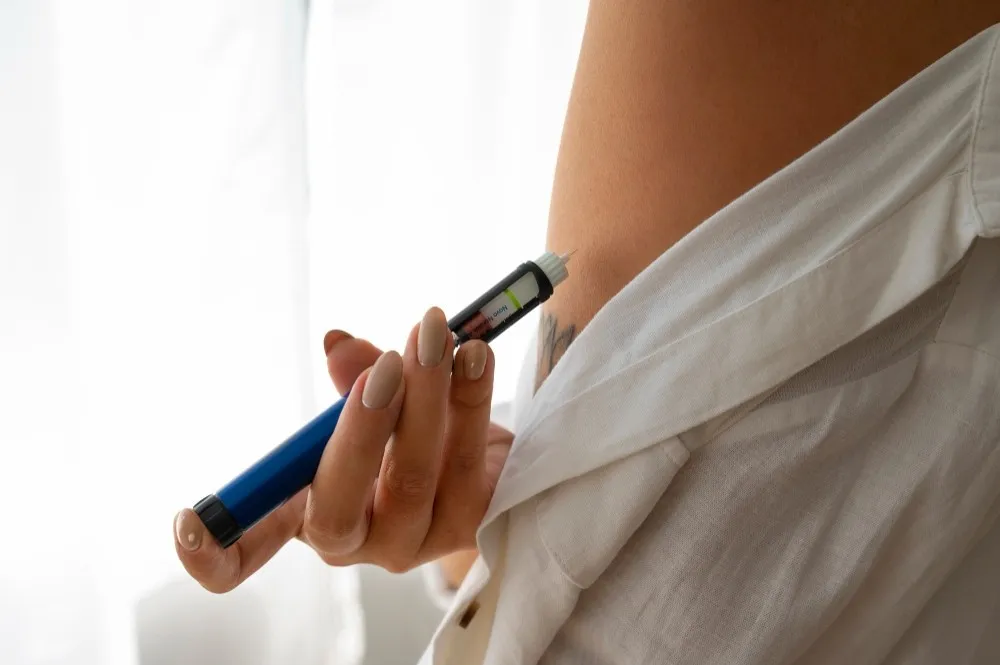Diabetes is a chronic condition that affects both elders and youngsters irrespective of their age, family background, etc. Type 1 and Type 2 diabetes are general classifications. Type 2 is commonly seen in elders whereas Type 1 targets youngsters, even kids. The key to managing or reversing diabetes lies in a combination of medication, exercise, and most importantly, a well-planned diet as some foods increase blood sugar levels.
Here's what foods to avoid with diabetes and what foods to add. Also, we’ll learn some tips to maintain healthy blood sugar levels.
10 Types of Foods to Avoid With Diabetes
As a diabetic, you should stick to a diabetic meal plan recommended by a doctor. The following are the worst foods for diabetes:
1. Full-fat Dairy Products
-
Dairy products such as full-fat butter and cheese, whole milk, and flavored yogurt contain saturated fats.
-
According to a study, saturated fats may affect insulin sensitivity and, as a result, contribute to type 2 diabetes.
-
So, avoid these foods and choose healthier options like Greek yogurt or almond milk, which are low-fat or plant-derived products.
2. Trans Fats
-
Found in margarine, baked goods, and processed spreads, trans fats increase insulin resistance, inflammation, and bad cholesterol.
-
All these factors can worsen the symptoms of diabetes.
-
Moreover, trans-fat-rich foods can lead to weight gain, which can also increase the severity of diabetes.
3. Sugary Foods
-
Cookies, cakes, doughnuts, pizza, and croissants and natural and artificial sweeteners such as honey, brown sugar, and maple syrup are the high-sugar foods to avoid as they contain low-quality carbs and sugar which can contribute to increased blood sugar levels.
-
Sugar can also cause weight gain and increase the chances of stroke and heart disease.
-
So, choose healthier options like fresh, whole fruits, homemade popsicles, or unsweetened yogurt in moderation.
4. White Carbohydrates
-
As white carbs lack fiber, they can easily break down in the body, causing a quick rise in blood sugar levels.
-
So, avoid white rice and pasta, packaged breakfast cereals, and regular pasta.
-
Instead have whole grains such as brown rice, oatmeal, quinoa, and whole wheat bread.
5. Processed Foods
-
Avoid canned goods, cookies, and other preserved items as they are highly processed and have hidden sugars and unhealthy additives.
-
These foods also have simple carbs that cause a quick rise in blood sugar levels.
-
The best choice is to find diabetes-friendly desserts like soft honey cookies, sugar-free chocolate fudge, sugar-free pudding, etc.
6. Processed Meats
-
Processed meats, including sausages, hot dogs, deli meats, bacon, and high-sodium meats, have added preservatives, sodium, and saturated fat.
-
Saturated fat and preservatives can lead to insulin resistance, thus worsening the condition.
-
High sodium can increase blood pressure, which is a common complication associated with diabetes.
-
Instead, have healthier options like eggs, tuna, salmon, chicken, and turkey.
7. Fried Foods
-
Deep-fried foods like fried chicken and French fries are unhealthy foods as they are fried in saturated fat-rich oil, which is extremely bad for managing diabetes.
-
Fried foods also consist of high sodium content, which leads to high blood pressure that can worsen diabetes.
-
So, the best idea is to bake or broil the food or use an air fryer instead.
8. High Sodium Foods
-
Though sodium (salt) does not directly impact blood sugar levels, it can raise blood pressure which can increase diabetes-related complications.
-
Increased blood pressure can also contribute to the risk of heart disease, like strokes and heart attacks, which are highly common in diabetic people.
-
Have fresh fruits, vegetables, whole grains, and lean proteins, and limit salty snacks, processed foods, and cured meats.
9. Certain Breakfast Cereals
-
Some breakfast cereals contain sugar, which is bad for diabetes management, as consuming added sugar in the morning can lead to high insulin levels and an increase in blood sugar levels.
-
This can increase the chances of obesity, which can further affect your approach to managing diabetes.
-
So, instead of breakfast cereals, have fruit-topped yogurt, whole-grain toast with avocado, eggs, or smoothies loaded with fruits, protein, and vegetables.
10. Dried Fruits
-
Dried fruits like raisins are high in concentrated sugars as the drying process leads to the removal of water content, contributing to a higher concentration of sugars per serving.
-
Choose dried fruits containing no added sugar and pair them with fiber or protein-rich foods to decrease the absorption of sugar in the blood.
-
Instead, go for low-sugar fresh fruits such as berries, peaches, or watermelon.
Besides medications, exercises, and other workouts, food, i.e., the diet, plays a key role in controlling and managing diabetes. A good diet is key to diabetes reversal.
Best Foods to Have If You Have Diabetes
The following are the diabetes-friendly food choices as they have a low glycemic index and are high in fiber and vitamins, helping maintain blood sugar levels:
-
Fatty Fish: Mackerel, sardines, and salmon are highly rich in omega-3 fatty acids that help manage diabetes in people who have high chances of stroke and heart disease.
-
Leafy Greens Vegetables: Being low in calories and digestible carbs, leafy greens like spinach and kale do not significantly impact blood sugar levels.
-
Avocados: Low in sugar and carbs and high in fiber, avocados maintain blood sugar levels.
-
Chia Seeds: Help maintain good glycemic control and reduce weight, which stabilizes blood sugar levels.
-
Nuts: Diabetic people who eat hazelnuts, walnuts, pistachios, and almonds can improve their blood sugar levels and have a low risk of heart disease.
-
Broccoli: With a low glycemic index, presence of sulforaphane, and high fiber content, broccoli can improve insulin sensitivity and blood sugar levels.
-
Berries: Being low in glycemic index and highly rich in antioxidants and fiber, berries like blueberries can improve blood sugar control.
-
Greek Yogurt: May help with weight loss and enhance body composition in diabetic people.
-
Eggs: Eating eggs can improve insulin sensitivity and reduce the chances of heart disease in people with diabetes.
-
Flaxseeds: Insoluble fiber in flaxseeds may help manage blood sugar levels and lower the risk of heart disease.
Creating a Plan for People With Diabetes
Use these strategies to create a diabetes-friendly, balanced, and health-promoting eating plan:
1. Plate Method
The simple, effective way to manage healthy blood sugar levels without measuring your food. It typically involves adjusting the portions of certain foods to create a well-balanced and nutritious plate.
To start:
-
Fill half of the plate with non-starchy veggies like cauliflower, broccoli, and leafy greens.
-
Next, fill one-quarter of the plate with protein-rich foods such as chicken, eggs, tofu, lean cuts of pork or beef, turkey, and fish.
-
Add carbohydrates like starchy vegetables, fruits, legumes, dairy products, and whole grains to the remaining quarter of the plate.
-
At last, pair the plate with low-calorie beverages like black coffee, club soda, unsweetened tea, or water to stay hydrated.
2. Carb Counting
This popular method for managing blood sugar levels
-
It involves tracking the portion of carbs in all foods you are eating every day.
-
In some cases, you might also be required to adjust the dosage of your insulin depending on the quantity of carbohydrates you intake.
-
The number of carbohydrates you should consume from each meal can vary slightly based on your age, activity level, and weight.
-
A registered dietitian can assist you in creating a customized plan based on your health needs.
3. Calculating Glycemic Index
Measuring glycemic index (GI) of foods is an effective approach to maintain blood sugar levels.
-
It is used to calculate how much specific foods raise blood sugar levels. This helps in categorizing them as high, medium, or low GI food depending on their effect on blood glucose levels.
-
When using this method, take foods with a medium or low glycemic index and limit the intake of foods with a high glycemic index.
Sample Menu for a Diabetes-friendly Meal
Here’s a simple, easy-to-prepare sample menu to start your day:
|
Breakfast |
Omelet with broccoli, peppers, and mushrooms. |
|
Morning snack |
A handful of high-quality almonds. |
|
Lunch |
Grilled chicken salad with balsamic vinaigrette, spinach, cucumber, tomatoes, and avocado. |
|
Afternoon snack |
Greek yogurt with walnuts & sliced strawberries. |
|
Dinner |
Baked salmon with nutritious asparagus and herb quinoa. |
|
Evening snack |
Sliced veggies with delicious hummus. |
Key Dietary Tips
Follow these dietary tips to keep your blood sugar levels stabilized:
1. Control Carbs
Carbohydrates are converted into glucose, raising blood sugar levels. Aim to:
-
Limit carbs to 45-50% of daily calorie intake.
-
Prioritize complex carbs like whole grains and non-starchy vegetables.
2. Increase Fiber & Protein
-
Eat 30g of fiber daily from veggies like broccoli, cabbage, or cauliflower.
-
Include lean proteins such as chicken, fish, and legumes.
3. Choose Healthy Fats
Incorporate unsaturated fats from sources like avocado, olive oil, sunflower oil, and seeds in moderation.
Tips for Lifestyle Changes To Manage Diabetes
A healthy lifestyle complements your dietary efforts. Make these changes to reduce complications:
-
Stay active: Aim for at least 30 minutes of exercise daily.
-
Manage stress: Practice yoga, meditation, or mindfulness techniques.
-
Quit smoking and alcohol: Both can worsen insulin resistance and lead to complications.
-
Prioritize sleep: Poor sleep can spike blood sugar levels.
Bottom Line
What foods to avoid with diabetes should be your first approach to manage or reverse diabetes effectively. Make sure to avoid processed foods, trans fats, sugary foods, fried foods, processed meats, and dried fruits. Instead, choose healthier options like berries, eggs, avocados, leafy green veggies, fatty fish, and nuts. With a healthy diet, adopt healthy lifestyle habits like regular exercise, stress management, and adequate rest.
Take charge of your health today! Explore personalized diabetes reversal programs for a guided approach to living a diabetes-free life.
Frequently Asked Questions
What is the first thing a diabetic should eat?
A well-balanced diet full of lean protein and fiber and low in carbs is the first thing a diabetic should have. The meal balances your blood sugar levels and provides energy.
Which vegetable is not good for diabetes?
Starchy vegetables such as peas, potatoes, butternut squash, and corn should be avoided or taken in moderation as they are highly rich in carbs that can increase blood sugar levels.
What is the one fruit that lowers blood sugar?
Apples can be a good choice as they have low glycemic index and high fiber content, helping manage diabetes.
What drink at bedtime lowers blood sugar?
Green tea is the best option as it has zero calories and is sugar-free. Also, it contains catechins that boost glucose metabolism, lowering blood sugar levels.
Is coffee good for diabetics?
No, coffee contains caffeine that can temporarily cause spikes in blood sugar levels in type 1 diabetics. Also, it can raise insulin resistance, worsening blood sugar levels.

Reviewed by







